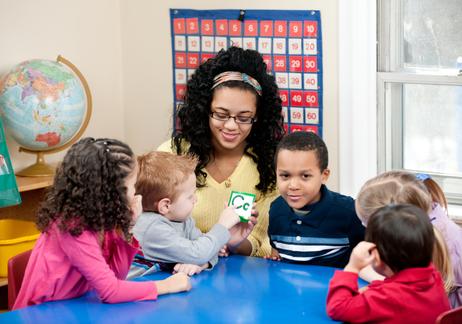Despite the nation’s dismal ranking for early childhood education, there are signs that it is for American families. Just a decade ago, only 65 percent of four-year-olds were enrolled in preschool; today, that number is 78 percent. It is a subject that has also become politicized, with President Obama championing the cause several times during his presidency, most notably in his 2013 State of the Union Address. After that speech, the White House offered details of the president’s plan to greatly expand the availability and quality of pre-k programs, :
- Expanding , which provides educational and health services to low-income and vulnerable children birth to three years of age;
- Developing a cooperative effort between state and federal agencies to guarantee pre-k enrollment for children at or below 200 percent of the poverty line;
- Build a corps of pre-k teachers that have the same level of credentials as those that teach K-12 students;
- Extending the provides home visits from nurses to low-income families. Nurses help promote health and positive parenting strategies from the child’s birth through their second birthday.
Many state legislatures have successfully enacted sweeping pre-k programs – Georgia and Oklahoma among them. However, the oddity of many state-based pre-K programs is that their success is far higher in states with poorer-performing public schools. Additionally, support for pre-k education seems much more robust in Republican-leaning states, especially those in the Deep South, like Texas, Louisiana, Florida, and South Carolina. However, despite this, a recent by Grow America Stronger shows that an overwhelming majority of Republicans, Democrats, and Independents support early childhood education. 71 percent of voters want expanded public education for preschoolers.
Success in Georgia, Oklahoma
Georgia has the in the nation. Open to all four-year-olds in the state, it is funded entirely by the Georgia lottery. Without being a tax burden on the state’s residents, the program is supported by even the most conservative Republicans, who tend to view increased taxes as a non-negotiable issue, even if that revenue is for education. Another factor that allowed a very Republican state to offer universal pre-k is that the program is fully based on choice – whether public, private, or otherwise. The preschool can apply for funding if it meets state requirements. By working together, Republicans and Democrats in Georgia have devised an early education system that sees 58 percent of the state’s four-year-olds attend school.
Another Republican state, Oklahoma, successfully implemented a universal pre-k program. Unlike in Georgia, the Oklahoma program is not funded by lottery earnings but is paid for through general state monies. Nearly 75 percent of Oklahoma four-year-olds attend preschool, a number beaten only by Florida, which enrolls almost 80 percent of four-year-olds. The Oklahoma program has been heavily studied for its long-term efficacy. The results are encouraging: Students participating in the state’s pre-k program show literacy and other skills gains through the third grade. These positive effects are seen most notably among low-income children, but gains are also demonstrated among children from more affluent families.
What Should Pre-K Look Like?
Certain aspects of how successful, high-quality pre-k systems should be structured are well-known based on the success of programs in Georgia and Oklahoma. For example, limits class sizes, so the student-to-teacher ratio is 10:1. That state also requires pre-k teachers to have a college degree and certification in early childhood education. Furthermore, pre-k teachers in the state are paid at a rate comparable to that of K-12 teachers, encouraging more qualified personnel to enter the field. The Oklahoma program also does not skimp on programming quality to save money.
As other states and nations try to figure out what early childhood education should look like, the latter point above is most important: Funding is everything. But in education, where there is funding, there is testing. What concerns some people in the education field is that universal pre-k would merely be an extension of the memorization and test-based formula of President Bush’s No Child Left Behind and President Obama’s Race to the Top, which already dictates in large part what is taught at the elementary, middle, and high school levels. These policies seek to prepare children for future educational pursuits and improve on-the-job performance. However, critics worry that implementing these “ram-and-cram” approaches in preschool leaves little time for play, creativity, and exploration. Indeed, having four-year-olds sit quietly through direct instruction, reciting memorized lists of letters and words while their performance is constantly being examined and quantified, sounds not just impossible but also doesn’t sound like something children who still take afternoon naps should be subjected to.

Map: Publically funded Pre-K by State Source: National Institute for Early Education Research
Research supports the concerns about the drill-and-skill methods of teaching young children. As reported by the , how children learn is just as important as how much they know. For example, poor parents who read to their children often spend time naming letters or sounding out words – fundamental and rote skills – while more affluent parents will ask their child questions, seeking information about what they think will happen next or how the story relates to real life. The latter approach is much more creative and in-depth, promoting critical thinking skills and creativity – experiences children in low-income families desperately need. However, many pre-k programs do not look like the latter scenario but the former, causing many to question what if any, good these kinds of methods will do when implemented in a pre-k setting.
Fueling these concerns is the president’s proposed shared funding structure by which the federal government would pay for the expense of expanded pre-k, but only to states that meet quality benchmarks. The problem with this funding model is that preschools will feel the push to produce quantifiable results, much like K-12 schools have done to meet the performance requirements of No Child Left Behind and Race to the Top. What’s been seen across the nation in K-12 classrooms is that to meet these standards, learning has become a sanitary and wholly disengaging process focused on what needs to be taught for students to pass tests and little more. This method of teaching and learning has drawn the ire of education experts and will undoubtedly stir up opposition if implemented in classrooms for four-year-olds.
Alternative Approaches to Pre-K
Alfie Kohn, an educational expert, and columnist for the Huffington Post, proposes a constructivist model of education in which children are actively engaged in creating their learning rather than sitting passively at a desk absorbing knowledge from their teacher. According to Kohn, is a far superior early education model because it utilizes themes of interest to young children, such as the weather, bugs, and babies, and engages children in learning about these topics for several weeks. This long-term study, which incorporates everything from reading, writing, thinking, drawing, and discussion, allows children to explore each topic in-depth and build an understanding of it in their world rather than being hurried from one task to another to “cover the bases” of what they should learn and know for evaluative purposes.
The idea of universal pre-k is a good one. Our educational system should be expanded and improved to ensure that all children, regardless of where they live or go to school, have access to high-quality learning experiences. However, ramrodding programs that focus on rote memorization and basic skills will not garner the results we want and need. The term “high quality” needs to mean just that, not “high intensity,” as it has come to mean when referring to the likes of No Child Left Behind. Four-year-olds need to learn in an environment rich in creativity, play, and exploration, not an environment in which they sit quietly at a desk and recite the alphabet. If universal pre-k is going to work, children need to have the latitude to extend their learning in a classroom that is both flexible and engaging.
Questions? Contact us on Facebook. @publicschoolreview














